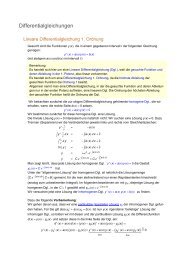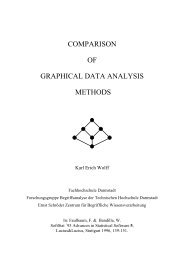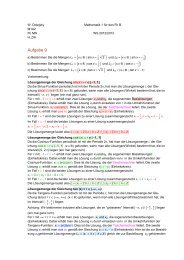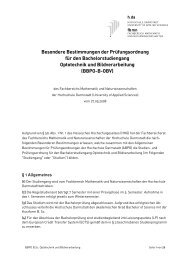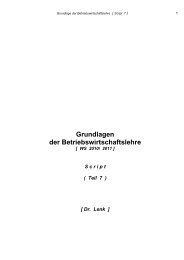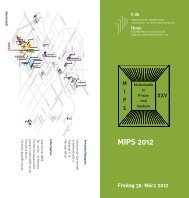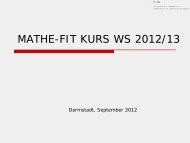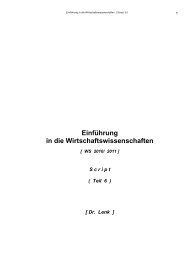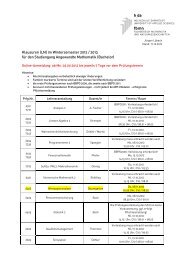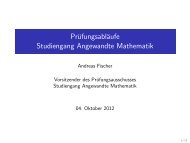Time Dimension, Objects, and Life Tracks - A Conceptual Analysis
Time Dimension, Objects, and Life Tracks - A Conceptual Analysis
Time Dimension, Objects, and Life Tracks - A Conceptual Analysis
You also want an ePaper? Increase the reach of your titles
YUMPU automatically turns print PDFs into web optimized ePapers that Google loves.
<strong>Time</strong> <strong>Dimension</strong>, <strong>Objects</strong>, <strong>and</strong> <strong>Life</strong> <strong>Tracks</strong> -<br />
A <strong>Conceptual</strong> <strong>Analysis</strong><br />
Karl Erich Wolff 1 , Wendsomde Yameogo 2<br />
1<br />
Department of Mathematics, 2 Department of Computer Science,<br />
Darmstadt University of Applied Sciences<br />
Schoefferstr. 3, D-64295 Darmstadt, Germany<br />
wolff@mathematik.tu-darmstadt.de,wendsomde@yameogo.com<br />
Abstract. The purpose of this paper is to clarify in the framework of Temporal<br />
Concept <strong>Analysis</strong> the distinction between the notion of the dimension of time<br />
<strong>and</strong> the one-dimensionality of life tracks of simple objects. The reader is led to<br />
the central problems by many examples.<br />
1 Introduction: Problems in the Representation of <strong>Time</strong><br />
At first we mention some basic problems arising in the representation of temporal<br />
phenomena. These problems led the authors to the introduction of conceptual structures<br />
for an appropriate description of processes. The mathematical background is<br />
Temporal Concept <strong>Analysis</strong> [23,24,25,26,27] which is based on Formal Concept<br />
<strong>Analysis</strong> [8,9,20,21,22].<br />
1.1 The Zenonian Paradox of the Flying Arrow<br />
One of the most famous problems in the representation of temporal phenomena is<br />
the Zenonian paradox of the flying arrow [2] which is in each moment of time fixed –<br />
but is flying. The classical solution of this paradox is the representation of time <strong>and</strong><br />
space by real numbers, the description of the arrow by a set of points or simply by a<br />
single point x which moves along a differentiable curve in the euclidean 3-space, <strong>and</strong><br />
the derivation at a time point t yields the velocity. That is a nice <strong>and</strong> very successful<br />
mathematical model <strong>and</strong> many people believe that the reality is like that – but how<br />
can we know that? Let us assume that we construct a virtual reality, simply by making<br />
a movie of a flying arrow. Then there are only finitely many pictures, each of<br />
them shown for a moment, <strong>and</strong> in each moment the arrow is fixed.<br />
Therefore, it is impossible to decide by finitely many measurements whether the<br />
flying arrow is fixed or flying in each moment. A formal representation of moments<br />
is one of the leading ideas in the construction of concentual time systems (see section<br />
2 <strong>and</strong> 3).
1.2 Aristotle <strong>and</strong> Kant: Change <strong>and</strong> Movement of <strong>Objects</strong><br />
Aristotle [2] in his physics has carefully discussed space <strong>and</strong> time as two of his ten<br />
categories, he studied change <strong>and</strong> movement, continuum <strong>and</strong> infinity, place <strong>and</strong> even<br />
empty place, bodies <strong>and</strong> objects, time order <strong>and</strong> the time point “now”. In his discussion<br />
of the object-space-time-process he studies the conceptual foundations of descriptions<br />
of objects in space <strong>and</strong> time.<br />
Immanuel Kant [15] also selected space <strong>and</strong> time as two of his twelve categories,<br />
either infinite, space of dimension three <strong>and</strong> time of dimension one. In his transcendental<br />
discussion of the concept of time Kant states:<br />
Hier füge ich noch hinzu, daß der Begriff der Veränderung und, mit ihm, der<br />
Begriff der Bewegung (als Veränderung des Orts) nur durch und in der Zeitvorstellung<br />
möglich ist: daß, wenn diese Vorstellung nicht Anschauung (innere)<br />
a priori wäre, kein Begriff, welcher es auch sei, die Möglichkeit einer<br />
Veränderung, d.i. einer Verbindung kontradiktorisch entgegengesetzter Prädikate<br />
(z.B. das Sein an einem Orte und das Nichtsein eben desselben Dinges<br />
an demselben Orte) in einem und demselben Objekte begreiflich machen<br />
könnte.<br />
Our translation:<br />
The concept of change <strong>and</strong>, together with it, the concept of motion (as a<br />
change of the place) is possible only by <strong>and</strong> within an idea of time: that, if<br />
that idea would not be an (internal) perception a priori, no concept whatsoever,<br />
could make comprehensible the possibility of a change, i.e. a connection<br />
of contradictory opposite predicates (e.g. being at a place <strong>and</strong> not being<br />
of just the same thing at the same place) in one <strong>and</strong> the same object.<br />
We shall give a formal description of a “conceptual time system with actual objects<br />
<strong>and</strong> a time relation” (CTSOT) which takes into account conceptually what Kant describes.<br />
That is done by defining objects using an identification <strong>and</strong> a “changement<br />
(or time) relation” among observed “actual objects” or “phenomena”.<br />
1.3 Poincaré <strong>and</strong> Einstein: Moments, Places, <strong>and</strong> Inaccuracy<br />
Contradicting Kant’s ‘a priori’ Poincaré [10] pointed out that mathematical theories<br />
should be used conventionally. That led to the possibility of using not only points (t,<br />
x, y, z) of the euclidean 4-space for the representation of a moment t <strong>and</strong> a place (x, y,<br />
z), but also to represent multi-dimensional places (x 1<br />
,…x n<br />
) (“states”) or (preparing our<br />
own notions) “situations” (t, x 1<br />
,…x n<br />
) as points in a multi-dimensional euclidean<br />
space. Then the difference vector between two states (or situations) seems to be a<br />
good description of a “movement”. But then the objects are not represented formally,<br />
only their states (or situations), but even not that, since a spatial object usually needs a<br />
little bit more than just a single point as its volume. Therefore, physicist like to talk
about “infinitely small particles”. The difficulties which arise from that simple representation<br />
of moments, places <strong>and</strong> objects can be seen from the following text by Albert<br />
Einstein [5], p. 415:<br />
Zur örtlichen Wertung eines in einem Raumelement stattfindenden Vorganges<br />
von unendlich kurzer Dauer (Punktereignis) bedürfen wir eines Cartesischen<br />
Koordinatensystems, d.h. dreier aufein<strong>and</strong>er senkrecht stehender, starr<br />
mitein<strong>and</strong>er verbundener, starrer Stäbe, sowie eines starren Einheitsmaßstabes.<br />
... Die Geometrie gestattet, die Lage eines Punktes bezw. den Ort eines<br />
Punktereignisses durch drei Maßzahlen (Koordinaten x, y, z) zu bestimmen....<br />
Für die zeitliche Wertung eines Punktereignisses bedienen wir uns einer Uhr,<br />
die relativ zum Koordinatensystem ruht und in deren unmittelbarer Nähe das<br />
Punktereignis stattfindet. Die Zeit des Punktereignisses ist definiert durch die<br />
gleichzeitige Angabe der Uhr.<br />
Our translation:<br />
For the spatial evaluation of an event of infinitesimal duration (point event)<br />
in a spatial element we need a cartesian coordinate system, i.e. three pairwise<br />
orthogonal, rigidly connected, rigid rods, <strong>and</strong> a rigid unit measure…The<br />
geometry allows for the determination of the position of a point respectively<br />
the place of a point event by three numbers (coordinates x, y, z)…<br />
For the temporal measurement of a point event we use a clock which is in<br />
rest relative to the coordinate system such that the point event happens very<br />
near to it. The time of the point event is defined by the simultaneous time<br />
state of the clock.<br />
Albert Einstein was aware of these difficulties even two years earlier. In his famous<br />
paper [4] (1905) Zur Elektrodynamik bewegter Körper where he introduced the special<br />
theory of relativity he wrote in the foot-note on page 893:<br />
Die Ungenauigkeit, welche in dem Begriffe der Gleichzeitigkeit zweier Ereignisse<br />
an (annähernd) demselben Orte steckt und gleichfalls durch eine<br />
Abstraktion überbrückt werden muß, soll hier nicht erörtert werden.<br />
Our translation:<br />
The inaccuracy which lies in the concept of simultaneity of two events at<br />
(about) the same place <strong>and</strong> which has to be bridged also by an abstraction,<br />
shall not be discussed here.<br />
The acceptance of a scientific treatment of inaccuracy by formal methods grew very<br />
slowly during the twentieth century because of the huge success of classical continuous<br />
mathematics in the natural sciences as well as the progress of discrete methods in<br />
computer sciences. But it remained a conceptual gap between continuous <strong>and</strong> discrete<br />
theories. Now, this gap can be bridged by the methods of Formal Concept <strong>Analysis</strong>.
1.4 Discrete Representations of <strong>Time</strong> <strong>and</strong> States<br />
The usual representation of the movements of figures on a chess board is a typical<br />
example of a discrete representation of a temporal process in some finite space. In<br />
many of these discrete problems we need only a discrete time representation, usually<br />
chosen as the set of integers with an appropriate structure, sometimes just with the<br />
usual ordering, sometimes with an ordered semigroup (or similar) structure.<br />
Automata theory [1,3] is based on the notions of states <strong>and</strong> transitions without an<br />
explicit time description. Mathematical System Theory [14,16,17] has tried to combine<br />
the notion of a state with an explicit time description, but without success as<br />
Zadeh [30], p. 40 states:<br />
To define the notion of state in a way which would make it applicable to all<br />
systems is a difficult, perhaps impossible, task. In this chapter, our modest<br />
objective is to sketch an approach that seems to be more natural as well as<br />
more general than those employed heretofore, but still falls short of complete<br />
generality.<br />
The first author [23] has introduced conceptual time systems with an explicit general<br />
time description such that the notion of state can be defined as generalizing the usual<br />
notions of states in physics [13] as well as in automata theory [1,3]. Before explaining<br />
the main ideas we first discuss the problems around granularity in the next subsection.<br />
1.5 Reasoning through Granularities<br />
In the following we use the term “granularity” (inspired by Lotfi Zadeh) in connection<br />
with descriptions using sets of subsets of a given set, for example partitions. A<br />
typical example is the granularity in time described by days, weeks, months <strong>and</strong><br />
years. In colloquial speech we say that the statement “In July Walter took a flight<br />
from Little Rock to Frankfurt” implies the statement “In the summer Walter travelled<br />
from the US to Germany”. To describe such a reasoning through granularities we<br />
need a formal representation of granularity. There are many approaches in the literature,<br />
the two most famous ones, namely Fuzzy Theory [31,32] <strong>and</strong> Rough Set Theory<br />
[18] are in some sense just special cases of <strong>Conceptual</strong> Scaling Theory [8] as shown<br />
by the first author [28,24].<br />
The importance of granularity lies also in the fact that the notion of “state” depends<br />
on the chosen granularity. That is obvious from the observation that the number<br />
of states of a system grows (usually rapidly) with a refinement of the granularity.<br />
Based on a clear conceptual system description <strong>and</strong> the notion of states of such a<br />
system we can introduce life tracks of objects (e.g. in the state space) which leads us<br />
to distinguish the time dimension of a system from the usually one-dimensional life<br />
tracks of objects. That will be discussed in the next sections.
2 Temporal Concept <strong>Analysis</strong><br />
Temporal Concept <strong>Analysis</strong> was introduced by the first author [23-27] as the theory<br />
of temporal phenomena described with tools of Formal Concept <strong>Analysis</strong> [8,9,20]. In<br />
the following we assume that the reader knows the basic facts in Formal Concept<br />
<strong>Analysis</strong> <strong>and</strong> <strong>Conceptual</strong> Scaling Theory. For an introduction we refer to [21,22].<br />
The development of Temporal Concept <strong>Analysis</strong> started with the introduction of<br />
conceptual time systems [23] such that states could be defined as object concepts of<br />
time points. Then transitions in conceptual time systems with a time relation were<br />
introduced in [26]. That led to the definition of the life track of a such a system. In a<br />
third step the idea that each object should be described by a conceptual time system<br />
with a time relation led to the definition of a CTSOT, a conceptual time system with<br />
actual objects <strong>and</strong> a time relation [27]. That led to the “map reconstruction theorem”<br />
which roughly says that each automaton can be represented by a CTSOT, proving<br />
that the notions of states <strong>and</strong> transitions in a CTSOT “cover” the notions of states <strong>and</strong><br />
transitions in automata theory. Therefore, CTSOTs provide a common generalization<br />
of (possibly continuous) physical systems as well as discrete temporal systems.<br />
To continue our discussion about the relation between objects, space <strong>and</strong> time we<br />
study the Venus example from [25], demonstrating a typical object construction <strong>and</strong><br />
the representation of life tracks of objects.<br />
2.1 Example: Morning Star – Evening Star<br />
In the following example we demonstrate the scientific process of theory extension<br />
based on some background theory. An important step in theory extension is the construction<br />
of new objects.<br />
The following Table 1 reports some observations of “luminous phenomena” at the<br />
sky.<br />
observation<br />
day day time space brightness<br />
1 Monday morning east luminous<br />
2 Monday evening west luminous<br />
3 Tuesday morning east luminous<br />
4 Tuesday evening west luminous<br />
Table 1 : Observations of stars<br />
For example, the observation labeled “1” states that at Monday morning in the east a<br />
luminous phenomenon was observed.<br />
We represent this table formally as a many-valued context <strong>and</strong> describe the background<br />
theory of the meaning of the values by conceptual scales. Using nominal
scales as in [25] the derived context [25] has the concept lattice represented by the<br />
line diagram in Figure 1.<br />
luminous<br />
east<br />
morning<br />
west<br />
evening<br />
Monday<br />
Tuesday<br />
1<br />
2<br />
3<br />
4<br />
Figure 1: A line diagram of the concept lattice of the nominally scaled manyvalued<br />
context in Table 1.<br />
Now, we give a short description of the main idea for the introduction of objects <strong>and</strong><br />
their life tracks. If we assume that the four observations of Table 1 are “caused” by a<br />
single object, called “Venus”, then it seems to be clear to draw the “life track” of<br />
Venus as in Figure 2.<br />
luminous<br />
east<br />
morning<br />
west<br />
evening<br />
Monday<br />
Tuesday<br />
1<br />
2<br />
3<br />
4<br />
Figure 2: The life track of Venus<br />
But until now we did not represent any ordering in our time description. Therefore,<br />
together with the introduction of an object we should represent formally that this<br />
object may be observed differently in different observations. Hence, each observation<br />
tells us something about the “actual object” observed during that observation. Therefore<br />
we introduce four actual objects for Venus, called (v,0), (v,1), (v,2), (v,3) <strong>and</strong><br />
introduce a binary relation among the actual objects, usually a sequence of actual<br />
objects, in our example: (v,0) → (v,1) → (v,2) → (v,3) .
We interpret the labels 0,1,2,3 in the actual objects as the “eigentime” (also called<br />
“proper time” in physics) of the object Venus. The common letter “v” characterizes<br />
the object Venus, an arrow of the time relation, for example (v,0) → (v,1), is interpreted<br />
as “the change of (v,0) to (v,1)”. Therefore, this time relation seems to be a<br />
suitable formal representation of the often used term “arrow of time” in physics<br />
[11,12]. It also represents nicely the ideas of Kant [15] mentioned in section 1.2.<br />
If we interpret the four observations of Table 1 as being caused by two stars, say<br />
the “Morning Star” <strong>and</strong> the “Evening Star” then we would draw the “life tracks” of<br />
them as in Figure 3.<br />
luminous<br />
east<br />
morning<br />
west<br />
evening<br />
Monday<br />
Tuesday<br />
1<br />
2<br />
3<br />
4<br />
Figure 3: The life tracks of Morning Star <strong>and</strong> Evening Star<br />
The corresponding conceptual time system with actual objects <strong>and</strong> a time relation<br />
(CTSOT) has the following data table:<br />
actual objects day day time space brightness<br />
(ms,0) Monday morning east luminous<br />
(es,0) Monday evening west luminous<br />
(ms,1) Tuesday morning east luminous<br />
(es,1) Tuesday evening west luminous<br />
Table 2: The data table of a conceptual time system with actual objects<br />
Its time relation is given by : (ms,0) → (ms,1) , (es,0) → (es,1) .<br />
In the following section we introduce the time dimension of a CTSOT.
3 <strong>Time</strong> <strong>Dimension</strong> <strong>and</strong> <strong>Life</strong> <strong>Tracks</strong><br />
After the demonstration of some examples we now need the formal definition of a<br />
CTSOT to introduce the time dimension of a CTSOT.<br />
3.1 Basic Definitions<br />
We just recall the basic definitions <strong>and</strong> relate them to the given examples.<br />
Definition: 'conceptual time system'<br />
Let G be an arbitrary set (of time objects) <strong>and</strong> T := ((G, M, W, I T<br />
), (S m<br />
| m ∈ M)) <strong>and</strong><br />
C := ((G, E, V, I), (S e<br />
| e ∈ E )) scaled many-valued contexts (on the same object set<br />
G). Then the pair (T, C) is called a conceptual time system on G. T is called the time<br />
part <strong>and</strong> C the event part of (T, C). The scales S m<br />
<strong>and</strong> S e<br />
of the time <strong>and</strong> event part<br />
describe the chosen granularity strucure for the values in these many-valued contexts.<br />
Example: Table 1 is the data table of a conceptual time system where G := {1,2,3,4},<br />
the two columns labeled “day” <strong>and</strong> “day time” represent the many-valued context of<br />
the time part, the two columns labeled “space” <strong>and</strong> “brightness” represent the manyvalued<br />
context of the event part. The used nominal scales are described in [25].<br />
Definition: 'conceptual time systems with actual objects <strong>and</strong> time relation'<br />
Let P be a set (of 'persons', or 'objects', or 'particles') <strong>and</strong> G a set (of 'points of time')<br />
<strong>and</strong> Π ⊆ P×G a set (of 'actual objects'). Let (T, C) be a conceptual time system on Π<br />
<strong>and</strong> R ⊆ Π × Π. Then the tuple (P, G, Π, T, C, R) is called a conceptual time system<br />
(on Π ⊆ P×G) with actual objects <strong>and</strong> a time relation R, shortly a CTSOT.<br />
For each object p ∈ P the set p Π := {g ∈ G| (p,g) ∈ Π} is called the (eigen)time of p<br />
in Π (which is the intent of p in the formal context (P, G, Π)). Then the set<br />
R p<br />
:= {(g,h) | ((p,g), (p,h)) ∈ R } is called the set of R-transitions of p <strong>and</strong> the relational<br />
structure (p Π , R p<br />
) is called the (eigen)time structure of p.<br />
Example: Table 2 is the data table of a CTSOT where P := {ms,es} is the set of<br />
Morning Star <strong>and</strong> Evening Star, G := {0, 1} the set of points of time. In this example<br />
Π = P×G <strong>and</strong> R := {((ms,0), (ms,1)) , ((es,0), (es,1))}. The relational structure ({0,<br />
1}, {(0,1)}) is the common eigentime structure of the Morning Star <strong>and</strong> the Evening<br />
Star. The conceptual time system of this CTSOT is described in the previous example.<br />
Definition: 'life track of an object'<br />
Let (P, G, Π, T, C, R) be a CTSOT, <strong>and</strong> p ∈ P. Then for any mapping f: {p}×p Π →<br />
X (into some set X) the set f = {((p,g),f(p,g))|g ∈ p Π } is called the f-life track (or f-<br />
trajectory or f-life line) of p. The two most useful examples for such mappings are the<br />
object mappings γ <strong>and</strong> γ C<br />
of the derived contexts K T<br />
⏐K C<br />
<strong>and</strong> K C<br />
of the conceptual<br />
time system (T, C, R) on Π, each of them restricted to the set {p}×p Π of actual ob-
jects. They are called the life track of p in the situation space <strong>and</strong> the life track of p in<br />
the state space respectively.<br />
Example: The life tracks of “Morning Star” <strong>and</strong> “Evening Star” in the situation space<br />
(where the time <strong>and</strong> the event part is represented) are shown in Figure 3 (where the<br />
labels 1,2,3,4 clearly should be replaced by the actual objects (ms,0), (es,0), (ms,1),<br />
(es,1)).<br />
3.2 <strong>Dimension</strong>s<br />
Definition: 'order dimension of an ordered set'<br />
An ordered set (P, ≤) has order dimension dim(P, ≤) = n if <strong>and</strong> only if it can be order<br />
embedded in a direct product of n chains <strong>and</strong> n is the smallest number for which this<br />
is possible ([9], p. 236). As usual, a chain is an ordered set (M, ≤) such that for any<br />
two elements a, b ∈ M a ≤ b or b ≤ a.<br />
Clearly, the order dimension of the ordered set (R, ≤), the set of real numbers <strong>and</strong><br />
their usual ordering, equals 1 <strong>and</strong> the n-fold direct product of this ordered set, the<br />
usual real n-dimensional space with the product order (R n , ≤) has order dimension n.<br />
Definition: 'order dimension of a scaled many-valued context'<br />
The order dimension of a scaled many-valued context ((G, M, W, I), (S m<br />
| m ∈ M)) is<br />
the order dimension of the concept lattice of its derived context.<br />
Definition: 'scale dimension of a scaled many-valued context'<br />
The scale dimension of a scaled many-valued context ((G, M, W, I), (S m<br />
| m ∈ M)) is<br />
the sum of the order dimensions of the concept lattices of the scales S m<br />
(m ∈ M).<br />
Since the concept lattice of the derived context of a scaled many-valued context can<br />
be order embedded in the direct product of the concept lattices of the scales (see [9],<br />
p. 77) we obtain:<br />
Lemma 1:<br />
The order dimension of a scaled many-valued context is less or equal to its scale<br />
dimension.<br />
Definition: 'time dimension of a conceptual time system'<br />
Let (T, C) be a conceptual time system. The time dimension of (T, C) is the order<br />
dimension of the time part T. Analogously, the (event or) space dimension of (T, C) is<br />
the order dimension of the event part C.<br />
Example: To demonstrate that these dimensions of a conceptual time system are a<br />
useful <strong>and</strong> for practical purposes relevant notion we study a formal representation of<br />
the following story:
A participant p of an international conference, let’s say the ICCS 2003, travels<br />
on Sunday morning from Darmstadt to Dresden, arrives at Dresden in the<br />
afternoon, visits the conference until Wednesday afternoon, then he has to<br />
travel back to Darmstadt arriving there in the evening.<br />
Figure 4 : <strong>Life</strong> tracks of a journey to Dresden: time scale dimension = 2<br />
In Figure 4 we have drawn (in a simplified way) the life tracks of the participant p in<br />
the state space, in the 2-dimensional time scale, <strong>and</strong> in the direct product of these two<br />
lattices, namely the situation space. To sketch the precise construction we represent<br />
the data table of the corresponding CTSOT with a single person p in Table 3:<br />
R actual person day day time town<br />
(p,0) Sunday morning Darmstadt<br />
(p,1) Sunday afternoon Dresden<br />
(p,2) Wednesday afternoon Dresden<br />
(p,3) Wednesday evening Darmstadt<br />
Table 3: The data table of the Dresden journey<br />
The three arrows represent the time relation R on the set of actual persons. The two<br />
attributes “day” <strong>and</strong> “day time” of the time part T <strong>and</strong> the attribute “town” of the<br />
event part C are scaled by ordinal scales of order dimension one. Therefore, the scale<br />
dimension of the time part T is two. Since the derived context of the time part of this<br />
CTSOT has a chain as its concept lattice the time dimension equals one. Clearly, if<br />
we would extend the CTSOT by a new actual object, say (p,3.0) which was at<br />
Wednesday morning in Dresden <strong>and</strong> change the time relation to (p,0) → (p,1) →<br />
(p,2) → (p,3.0) → (p,3) then the time dimension would be two. That demonstrates<br />
why we are often interested only in the scale dimension.
3.3 The Unique-State Theorem<br />
A very popular statement, namely that each system is in each point of time in exactly<br />
one state can be made precise for CTSOTs <strong>and</strong> can be proven easily.<br />
Definition:<br />
Let (P, G, Π, T, C, R) be a CTSOT <strong>and</strong> (p,g) ∈ Π. We say that p is at time point g in<br />
the situation s (or that the actual object (p,g) is in the situation s) iff s = γ((p,g)); (p,g)<br />
is in the time state s iff s = γ T<br />
((p,g)), <strong>and</strong> (p,g) is in the state s iff s = γ C<br />
((p,g)).<br />
Theorem: 'unique-state theorem'<br />
Let (P, G, Π, T, C, R) be a CTSOT. Then each object p ∈ P is at each time point g of<br />
its eigentime in exactly one situation, in exactly one time state <strong>and</strong> in exactly one<br />
state.<br />
Proof: Let (p,g) ∈ Π, then clearly γ((p,g)) is the only situation s such that p is at time<br />
point g in the situation s. In the same way the rest of the theorem can be proved.<br />
Remark: We do not know any formal theory where this popular theorem was stated or<br />
even proved. It seems to be that some people use that statement as a kind of description<br />
of a state.<br />
It seems to be obvious that as a consequence of the unique-state theorem the eigentime<br />
structure of an object looks like a (graph theoretic) chain, for example 0 → 1 →<br />
2. That is not true as shown in the next section.<br />
3.4 Branching <strong>Time</strong> <strong>and</strong> Branching <strong>Objects</strong>?<br />
The following example demonstrates a CTSOT with a single object <strong>and</strong> a “branching”<br />
time relation. It describes an “abstract letter”, that is a class of “identical” copies<br />
of an original letter. As usual, we say that the abstract letter is sent from A to B iff a<br />
copy of the original letter is sent from A to B.<br />
Example: 'an abstract letter'<br />
An abstract letter is sent on day 0 from place A to place B arriving there on day 1,<br />
<strong>and</strong> on day 0 from A to the place C arriving there on day 2. Then the letter is sent on<br />
day 1 from B to the place D <strong>and</strong> on day 2 from C to D either arriving on day 3.<br />
Some of the information is represented in the following CTSOT with an ordinal scale<br />
for the attribute “day” <strong>and</strong> a nominal scale for the “place”.
Table 4: A “branching” abstract letter<br />
R actual objects day place<br />
(letter,0) 0 A<br />
(letter,1) 1 B<br />
(letter,2) 2 C<br />
(letter,3) 3 D<br />
Clearly, this “branching” abstract letter can be described by its copies as in Table 5.<br />
Table 5: Two copies as “simple” objects<br />
R actual objects day place<br />
(copy1,0) 0 A<br />
(copy1,1) 1 B<br />
(copy1,3) 3 D<br />
(copy2,0) 0 A<br />
(copy2,2) 2 C<br />
(copy2,3) 3 D<br />
Therefore, it is necessary to introduce a clear definition of “simple” objects:<br />
Definition: 'simple objects'<br />
An object p of a CTSOT is called simple iff the restriction of the time relation R on<br />
the actual objects of p, i.e. R ∩ ({p}×p Π ) 2 , has a chain c p<br />
:= ({p}×p Π , ≤ p<br />
) as its reflexive<br />
<strong>and</strong> transitive closure.<br />
Let p be a simple object of a CTSOT <strong>and</strong> f: {p}×p Π → X a mapping into some set X.<br />
Then the f-life track {((p,g), f(p,g)) | g ∈ p Π } of p can be ordered in a trivial way<br />
isomorphically to c p<br />
by the following definition of an order relation ≤ f<br />
on f:<br />
((p,g), f(p,g)) ≤ f<br />
((p,h), f(p,h)) : ⇔ (p,g) ≤ p<br />
(p,h).<br />
Hence the ordered life-track (f, ≤ f<br />
) of a simple object p is one-dimensional in the<br />
sense that it is a chain (which is isomorphic to c p<br />
). Note that f need not be injective.<br />
4 Conclusion <strong>and</strong> Future Research<br />
It is shown that <strong>Conceptual</strong> <strong>Time</strong> Systems with Actual <strong>Objects</strong> <strong>and</strong> a <strong>Time</strong> Relation<br />
(CTSOT) allow for distinguishing clearly between the time dimension of a conceptual<br />
time system <strong>and</strong> the order dimension of the chain c p<br />
of a simple object of a CTSOT.<br />
The shown existence of non-simple objects <strong>and</strong> their applicability to ideas like an<br />
“abstract letter” open up interesting problems in the conceptual representation of<br />
central notions in other branches of science like for example in computer science<br />
where “information” <strong>and</strong> “object oriented programming” <strong>and</strong> its time-conceptual
foundations as developed by the second author in [29] now can be investigated from a<br />
formal conceptual base. Clearly, also many fundamental problems in physics<br />
[11,12,13] <strong>and</strong> Temporal Logic [7,19] will be studied using these methods.<br />
5 References<br />
1. Arbib, M.A.: Theory of Abstract Automata. Prentice Hall, Englewood Cliffs, N.J.,<br />
1970.<br />
2. Aristoteles: Philosophische Schriften in sechs Bänden. Felix Meiner Verlag Hamburg<br />
1995.<br />
3. Eilenberg, S.: Automata, Languages, <strong>and</strong> Machines. Vol. A. Academic Press 1974.<br />
4. Einstein, A.: Zur Elektrodynamik bewegter Körper. Annalen der Physik 17 (1905):<br />
891-921.<br />
5. Einstein, A.: Über das Relativitätsprinzip und die aus demselben gezogenen Folgerungen.<br />
In: Jahrbuch der Radioaktivität und Elektronik 4 (1907) : 411-462.<br />
6. Einstein, A.: The collected papers of Albert Einstein. Vol. 2: The Swiss Years:<br />
Writings, 1900-1909. Princeton University Press 1989.<br />
7. Gabbay, D.M., I. Hodkinson, M. Reynolds: Temporal Logic – Mathematical<br />
Foundations <strong>and</strong> Computational Aspects. Vol.1, Clarendon Press Oxford 1994.<br />
8. Ganter, B., R. Wille: <strong>Conceptual</strong> Scaling. In: F.Roberts (ed.) Applications of combinatorics<br />
<strong>and</strong> graph theory to the biological <strong>and</strong> social sciences,139-167. Springer<br />
Verlag, New York, 1989.<br />
9. Ganter, B., R. Wille: Formal Concept <strong>Analysis</strong>: mathematical foundations. (translated<br />
from the German by Cornelia Franzke) Springer-Verlag, Berlin-Heidelberg<br />
1999.<br />
10.Gottwald, S. (ed.): Lexikon bedeutender Mathematiker. Bibliographisches Institut<br />
1990.<br />
11.Hawking, S.: A Brief History of <strong>Time</strong>: From the Big Bang to Black Holes. Bantam<br />
Books, New York 1988.<br />
12.Hawking, S.: Penrose, R.: The Nature of Space <strong>and</strong> <strong>Time</strong>. Princeton University<br />
Press, 1996.<br />
13.Isham, C.J.: <strong>Time</strong> <strong>and</strong> Modern Physics. In: Ridderbos, K. (ed.): <strong>Time</strong>. Cambridge<br />
University Press 2002, 6-26.<br />
14.Kalman, R.E., Falb, P.L., Arbib, M.A.: Topics in Mathematical System Theory.<br />
McGraw-Hill Book Company, New York, 1969.<br />
15.Kant, I.; Kritik der reinen Vernunft, in: Weischedel, W. (ed.): Immanuel Kant –<br />
Werke in sechs Bänden. B<strong>and</strong> II, Insel Verlag, Wiesbaden 1956 (first edition<br />
1781).<br />
16.Lin, Y.: General Systems Theory: A Mathematical Approach. Kluwer Academic/<br />
Plenum Publishers, New York, 1999.<br />
17.Mesarovic, M.D., Y. Takahara: General Systems Theory: Mathematical Foundations.<br />
Academic Press, London, 1975.<br />
18.Pawlak, Z.: Rough Sets: Theoretical Aspects of Reasoning About Data. Kluwer<br />
Academic Publishers, 1991.
19.van Benthem, J.: Temporal Logic. In: Gabbay, D.M., C.J. Hogger, J.A. Robinson:<br />
H<strong>and</strong>book of Logic in Artificial Intelligence <strong>and</strong> Logic Programming. Vol. 4,<br />
Epistemic <strong>and</strong> Temporal Reasoning. Clarendon Press, Oxford, 1995, 241-350.<br />
20.Wille, R.: Restructuring lattice theory: an approach based on hierarchies of concepts.<br />
In: Ordered Sets (ed. I.Rival). Reidel, Dordrecht-Boston 1982, 445-470.<br />
21.Wille, R.: Introduction to Formal Concept <strong>Analysis</strong>. In: G. Negrini (ed.): Modelli e<br />
modellizzazione. Models <strong>and</strong> modelling. Consiglio Nazionale delle Ricerche, Instituto<br />
di Studi sulli Ricerca e Documentatione Scientifica, Roma 1997, 39-51.<br />
22.Wolff, K.E.: A first course in Formal Concept <strong>Analysis</strong> - How to underst<strong>and</strong> line<br />
diagrams. In: Faulbaum, F. (ed.): SoftStat ´93, Advances in Statistical Software 4,<br />
Gustav Fischer Verlag, Stuttgart 1994, 429-438.<br />
23.Wolff, K.E.: Concepts, States, <strong>and</strong> Systems. In: Dubois, D.M. (ed.): Computing<br />
Anticipatory Systems. CASYS´99 - Third International Conference, Liège, Belgium,<br />
1999, American Institute of Physics Conference Proceedings 517, 2000, pp.<br />
83-97.<br />
24.Wolff, K.E.: A <strong>Conceptual</strong> View of Knowledge Bases in Rough Set Theory. In:<br />
Ziarko, W., Yao, Y. (eds.): Rough Sets <strong>and</strong> Current Trends in Computing. Second<br />
International Conference, RSCTC 2000, Banff, Canada, October 16-19, 2000, Revised<br />
Papers, 220-228.<br />
25.Wolff, K.E.: Temporal Concept <strong>Analysis</strong>. In: E. Mephu Nguifo & al. (eds.): ICCS-<br />
2001 International Workshop on Concept Lattices-Based Theory, Methods <strong>and</strong><br />
Tools for Knowledge Discovery in Databases, Stanford University, Palo Alto<br />
(CA), 91-107.<br />
26.Wolff, K.E.: Transitions in <strong>Conceptual</strong> <strong>Time</strong> Systems. In: D.M.Dubois (ed.):<br />
Computing Anticipatory Systems CASYS'2001, American Institute of Physics<br />
Conference Proceedings.<br />
27.Wolff, K.E.: Interpretation of Automata in Temporal Concept <strong>Analysis</strong>. In: U.<br />
Priss, D. Corbett, G. Angelova (eds.): Integration <strong>and</strong> Interfaces. Tenth International<br />
Conference on <strong>Conceptual</strong> Structures. Lecture Notes in Artificial Intelligence.<br />
Springer-Verlag 2002.<br />
28.Concepts in Fuzzy Scaling Theory: Order <strong>and</strong> Granularity. 7 th European Congress<br />
on Intelligent Techniques <strong>and</strong> Soft Computing, Aachen 1999. Fuzzy Sets <strong>and</strong> Systems<br />
132 (2002) 63-75.<br />
29.Yameogo, W.: <strong>Conceptual</strong> Knowledge Processing. <strong>Time</strong> <strong>Conceptual</strong> Foundations<br />
of Programming. Master Thesis. Department of Computer Science at Darmstadt<br />
University of Applied Sciences, 2003.<br />
30.Zadeh, L.A.: The Concept of State in System Theory. In: M.D. Mesarovic: Views<br />
on General Systems Theory. John Wiley & Sons, New York, 1964, 39-50.<br />
31.Zadeh, L.A.; Fuzzy sets. Information <strong>and</strong> Control 8, 1965, 338 - 353.<br />
32.Zadeh, L.A.; The concept of a linguistic variable <strong>and</strong> its application to approximate<br />
reasoning. Part I: Inf. Science 8,199-249; Part II: Inf. Science 8, 301-357;<br />
Part III: Inf. Science 9, 43-80, 1975.



